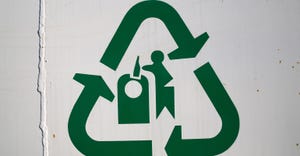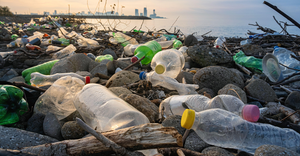
“Is recycling broken?” It’s a question I am frequently asked. The answer is that recycling is not “broken” – but as it stands, it is still too specialized to reach the goal of achieving a complete circular economy. To achieve this goal, we need to embrace the opportunities that recycling can offer – a mass market solution that’s affordable and available to everyone, everywhere.
At present, only 9% of the plastic made each year is recycled, which is nowhere near the level required to create an environment where we have enough resources for all the people around the world. Even accounting for the fact that almost half of plastic remains in use more than a year after being placed in the market (i.e. electronics, automobile parts, furniture, pipe and such) there is still tremendous opportunity to grow recycling. And with the pandemic causing recycling efforts to take an even greater hit, it is more important now than ever to improve recycling efforts as society aims to build back better – or as I like to say, build forward better.
The good news is that we are on the path to achieving higher levels of recycling adoption through efforts to expand recycling operations, increase consumer demand for recycled products, and innovation in the space – but there is still much more work to be done. And while the task might seem daunting, I believe we can prioritize three key areas in order to achieve mass adoption of recycling around the world.
Global expansion of existing systems
Millions of households in the U.S. don’t have access to recycling at home – which is unacceptable in the most prosperous nation on earth. There are concerted efforts happening at home and around the globe to expand and create new recycling systems to provide more people with opportunities to be a part of the solution to reduce waste.
For example, in rural areas, there often isn’t enough population density to make it economical to invest in trucks when the cost of that equipment would end up being split between a small number of homes. That’s where startups, such as Recyclops comes into play. Through an Uber-like model, Recyclops brings collection to areas where it otherwise would not be feasible. These efforts contribute to making a sustainable lifestyle accessible and affordable to many.
Another example of support for expansion of systems is The Recycling Partnership, which gives cities grants to expand recycling within their own cities, providing supplies and consulting services. These activities are funded by companies across the industry, including those aiming to increase recycled content in their company’s packaging.
Consumer demand for recycled products
The pandemic has fundamentally shifted consumer purchasing habits. Safety concerns related to the pandemic have led to an increased demand for certain types of plastic products, such as packaging and personal protective equipment. As a result, consumers are becoming more aware than ever of the need for greater sustainability measures to manage the increase in plastic consumption, and this impetus on sustainability is driving companies to rethink the recyclability of their products to meet consumer demand.
For example, Dove has designed a new alternative to reduce the amount of plastic consumers use each year on deodorant alone, especially since a typical plastic deodorant stick ends up in the trash within months. The newly designed case, which is made from stainless steel, can be refilled with inserts that click into place, using 54% less plastic than the brand’s regular deodorant, and ensuring that 98% of the plastic it does use gets recycled.
Another example of consumer demand influencing the development of recycled products is Mars, Inc., which recently announced it will incorporate recycled polypropylene plastic into its packaging for some of its pet food brands in order to reduce virgin plastic use across its packaging portfolio. This ultimately contributes to a more circular economy where eventually no packaging will become waste.
Additionally, Alima Pure, a carbon-neutral certified B Corp and member of 1% for the Planet realized that the beauty industry produces a lot of plastic waste, so in response, the brand positioned itself as an eco-friendly cosmetics alternative, selling makeup in refillable components.
At Dow, we’re also focused on designing products for recyclability. We partnered with Kashi to deliver the first resealable stand-up pouches for Kashi’s Bear Naked granola to be fully recyclable, keeping up with the demands of consumers for more recyclable packaging and positively contributing to the increased adoption of recycling.
Innovation
Advancements in innovative recycling solutions will help us meet the end goal of recycling plastic in an endless series of interconnected loops. Continued innovation in recycling is making processes more efficient and less expensive – laying the foundation for more widespread adoption.
Automation technology is being utilized for more efficient recycling processes, which allows smarter machines to sort recycled materials more efficiently. For example, AMP Robotics utilizes advanced computer vision and machine learning to improve the precision and accuracy of recycling sortation. The technology recognizes products and compiles metrics on how products are making it through the recycling system. In turn, this provides brands the opportunity to recycle and reinvent specific products within a closed loop. Coffee cups, for instance, are now being recycled in Denver because of this type of innovation.
IBM has new technology that can recycle mixed and contaminated plastic that would have been difficult to keep within a circular economy. Nowadays, a cotton-polyester-blend T-shirt can be transformed back into pure cotton and pure, virgin-quality polyester.
Additionally, Suntory in Japan is innovating the normally extended process of making recycled bottles by cutting out the middle part of the process to make the overall effort more efficient. This makes the processing time shorter, while aiming to significantly reduce the environmental impact of recycling.
To create a resilient, resource-efficient circular system where our resources get used over and over will require universal collection, better sorting systems, advanced recycling technologies, and a robust set of end-uses for recycled plastics.
By improving the adoption of recycling and ensuring we pay attention to the entire system needed to make everything work, we have the opportunity to reduce carbon emissions, reduce the extraction of raw materials, and positively impact resource and waste management.
Achieving this goal will take more than any one individual or organization can achieve on their own. We must work together with all stakeholders to create a society – not just a recycling program – that is more circular, more resilient, and ultimately more sustainable
About the Author(s)
You May Also Like


